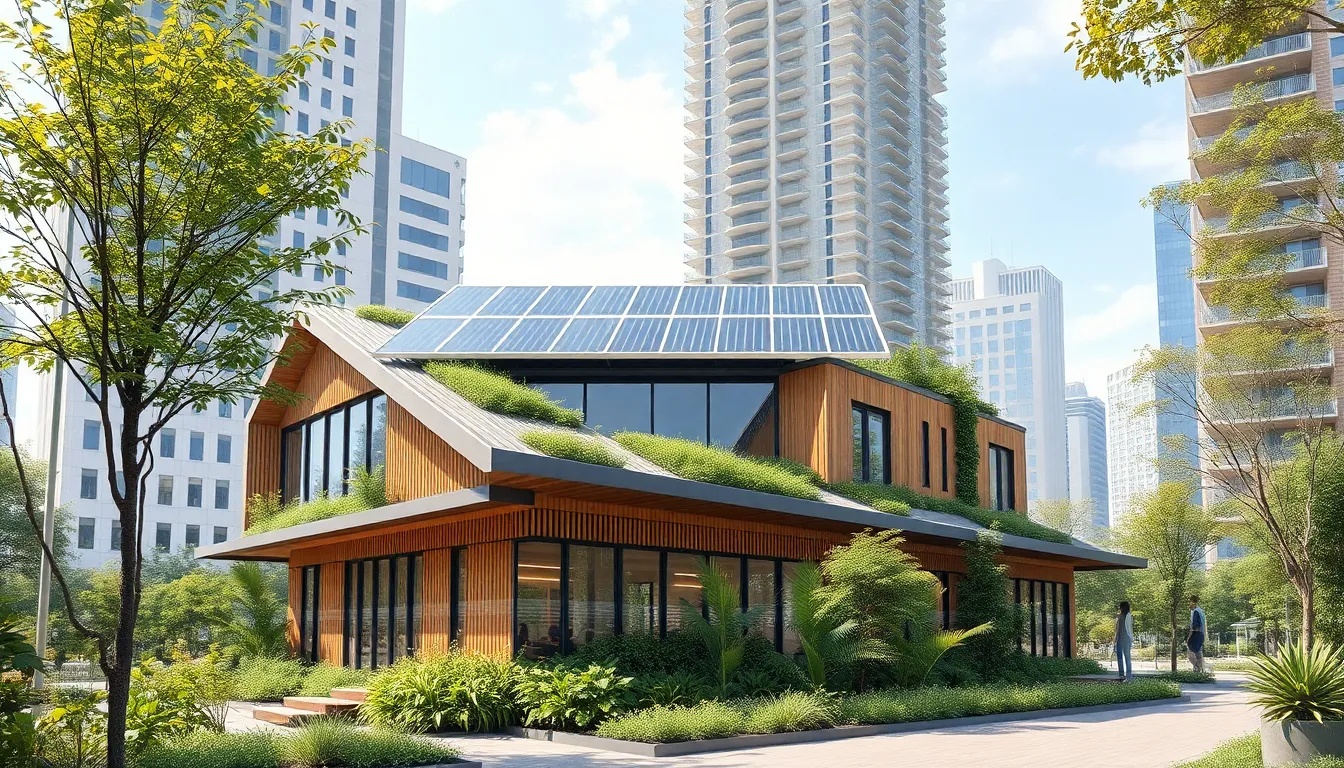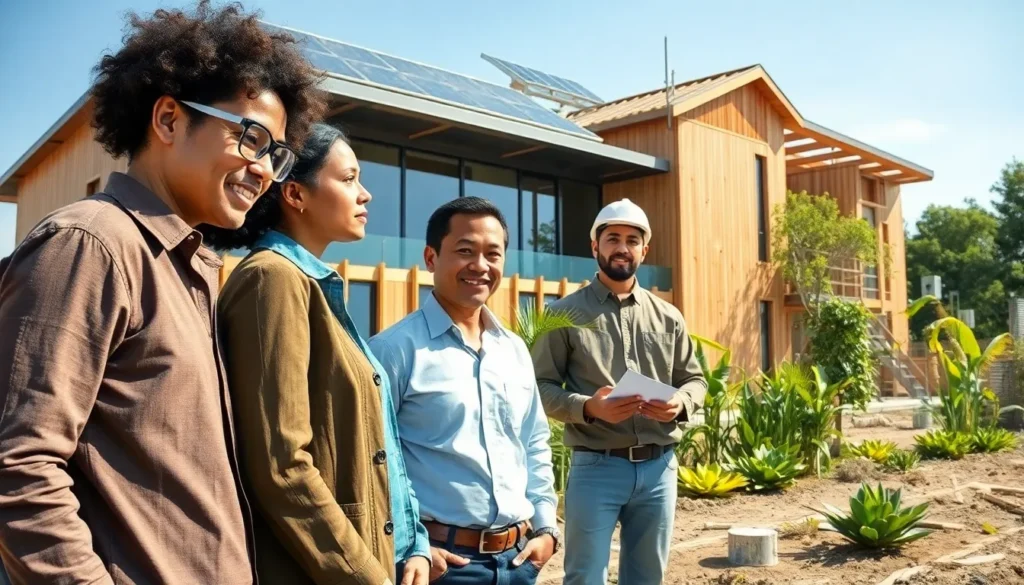In a world where Mother Nature is raising her eyebrows at our building habits, sustainable building technology swoops in like a superhero. It’s not just about saving the planet; it’s about making smart choices that save money and keep the air fresh enough to breathe. Imagine living in a home that’s not only stylish but also eco-friendly.
From solar panels that soak up sunshine like a sunbather to materials that would make even the most hardened environmentalist shed a tear of joy, sustainable building technology is the future—today. It’s time to swap those outdated practices for innovations that not only reduce carbon footprints but also offer comfort and efficiency. So, buckle up as we explore how these technologies are transforming the construction landscape and why they should be on everyone’s radar.
Table of Contents
ToggleOverview of Sustainable Building Technology
Sustainable building technology encompasses practices that minimize environmental impact throughout a structure’s lifecycle. This approach includes energy-efficient designs that reduce consumption and reliance on non-renewable resources. Innovations like solar panels play a crucial role in harnessing renewable energy, transforming buildings into productive energy consumers.
Use of eco-friendly materials significantly enhances sustainability. Organic materials such as bamboo, recycled steel, and reclaimed wood not only reduce waste but also lower the carbon footprint of constructions. Implementation of proper insulation also contributes to energy savings and improved indoor air quality.
Smart building systems integrate technology to manage resources efficiently. These systems can automate lighting, heating, and cooling based on occupancy, further optimizing energy use. Building information modeling (BIM) provides architects and engineers with tools to design structures that meet sustainability goals from the outset.
Local sourcing is another vital aspect of sustainable building. Using materials sourced closer to the construction site decreases transportation emissions and supports local economies. Additionally, considering the ecological impact during the building’s operation promotes longevity and reduces overall environmental burdens.
Innovations in water management tackle another significant concern. Rainwater harvesting and greywater recycling systems reduce water consumption, which is crucial in regions with limited resources. Advanced landscaping techniques, such as xeriscaping, enhance water conservation by utilizing drought-resistant plants.
Regulated by standards like LEED (Leadership in Energy and Environmental Design), sustainable building technology must adhere to strict guidelines. Certification under these standards requires meeting specific energy and environmental performance criteria, ensuring accountable progress toward sustainability.
These various elements collectively push the construction industry toward a greener future. As sustainable building practices evolve, they promise greater adaptability, resilience, and eco-friendliness for upcoming generations.
Benefits of Sustainable Building Technology

Sustainable building technology brings multiple advantages that contribute to a healthier planet and society. These benefits encompass environmental, economic, and social dimensions.
Environmental Impact
Sustainable building technology significantly reduces the ecological footprint of structures. It promotes energy-efficient designs that lessen the dependence on fossil fuels, directly decreasing greenhouse gas emissions. The incorporation of renewable energy solutions, particularly solar panels, plays a crucial role in harnessing clean energy. Eco-friendly materials, like bamboo and recycled steel, minimize waste and cut down carbon footprints during production and construction. Water conservation measures, such as rainwater harvesting, further enhance sustainability by reducing pressure on local water resources.
Economic Advantages
Sustainable buildings offer tangible economic benefits that enhance both initial investments and long-term savings. Energy-efficient designs lower utility costs through reduced energy consumption, often translating to savings of 30-50% on energy bills. Many jurisdictions provide financial incentives, such as tax credits and grants, for using eco-friendly construction methods. Additionally, sustainable buildings often command higher market values, making them appealing to investors and buyers. Ultimately, the initial investment in sustainable technology yields substantial returns over time.
Social Benefits
Communities reap numerous social advantages from sustainable building technology. Improved air quality enhances occupants’ health by reducing pollutants and allergens, creating a more comfortable living environment. Moreover, these buildings often incorporate elements that promote well-being, such as natural lighting and green spaces. Sustainable practices foster community engagement through local sourcing of materials, supporting nearby economies. In addition, designs that emphasize accessibility create inclusive environments, ensuring everyone can benefit from these advancements.
Key Components of Sustainable Building Technology
Sustainable building technology incorporates various components that collectively enhance environmental stewardship. Energy efficiency, sustainable materials, and water conservation form the backbone of these innovative practices.
Energy Efficiency
Energy-efficient designs significantly lower energy consumption in buildings. Incorporating high-performance windows reduces heating and cooling demands. Insulation materials enhance thermal comfort while minimizing energy waste. Smart technology simplifies energy management, allowing users to track and control consumption more effectively. Additional features, such as LED lighting and Energy Star appliances, contribute to substantial energy savings. Adopting these strategies decreases reliance on non-renewable resources, leading to a reduced carbon footprint.
Sustainable Materials
Sustainable materials play a crucial role in building eco-friendly structures. Using renewable resources like bamboo and reclaimed wood minimizes deforestation impacts. Recycled steel not only lowers waste but also promotes circular economy principles. Non-toxic finishes enhance indoor air quality, providing a healthier living environment. Local sourcing reduces transportation emissions, benefiting both the environment and local economies. Prioritizing sustainable materials enables developers to construct resilient structures that stand the test of time.
Water Conservation
Water conservation strategies effectively reduce waste and promote sustainability. Rainwater harvesting systems capture and utilize rainwater for irrigation and non-potable uses. Implementing low-flow fixtures and appliances enhances water efficiency, resulting in lower utility bills. Xeriscaping, or landscaping that uses drought-resistant plants, decreases the need for irrigation. These approaches mitigate the strain on local water supplies, ensuring long-term availability. By integrating water conservation practices, buildings contribute to a sustainable future while preserving this vital resource.
Innovations in Sustainable Building Technology
Innovations in sustainable building technology drive the construction industry toward eco-friendliness and efficiency. These advancements encompass smart building systems and renewable energy integration, crucial for minimizing environmental impacts.
Smart Building Systems
Smart building systems utilize automation to enhance energy management and optimize resource usage. Sensors and real-time data monitoring adjust lighting, heating, and cooling based on occupancy and environmental conditions, significantly reducing waste. Many buildings now incorporate advanced HVAC systems, which provide energy-efficient climate control. Additionally, occupancy detection helps minimize energy consumption in unoccupied spaces. As a result, these systems not only cut operational costs but also improve overall building performance and occupant comfort.
Renewable Energy Integration
Renewable energy integration plays a vital role in sustainable building technology. Solar panels transform sunlight into electricity, helping buildings to rely less on traditional energy sources and reducing greenhouse gas emissions. Many recent projects also incorporate wind turbines to harness wind energy, further diversifying energy options. Geothermal systems utilize the Earth’s consistent temperatures for heating and cooling, offering significant energy savings. With storage solutions becoming more efficient, excess energy generated can be used during peak demand periods, ensuring sustainability and energy security.
Challenges and Solutions in Sustainable Building Technology
Sustainable building technology faces several significant challenges. High initial costs often deter developers and property owners from investing in eco-friendly solutions. Effective financing models can alleviate these concerns, making sustainable options more accessible.
Another challenge includes regulatory hurdles that complicate the implementation of sustainable practices. Governments and regulatory bodies can streamline processes for obtaining permits. Simplified guidelines encourage the adoption of green technologies.
Limited awareness of sustainable practices exists among construction professionals. Comprehensive training programs and workshops can educate these individuals, equipping them with the knowledge to implement sustainable solutions effectively.
Supply chain issues can hinder the availability of eco-friendly materials. Engaging with local suppliers can enhance access to sustainable resources while minimizing transportation emissions. Regional partnerships can strengthen local economies.
Design constraints frequently arise when integrating sustainable technologies into existing structures. Innovative retrofitting techniques can allow older buildings to adopt greener systems without extensive renovations. These techniques extend the lifespan of structures while reducing their environmental impact.
Energy efficiency in extreme weather conditions poses additional challenges. Advanced building materials with high thermal performance can mitigate this issue, providing better insulation and reducing energy consumption. Utilizing smart building management systems enhances energy responsiveness.
Water management strategies face obstacles related to infrastructure limitations. Implementing decentralized systems, such as rainwater harvesting, offers practical solutions for conserving water. These systems ensure greater resilience during droughts.
Addressing these challenges through strategic solutions enhances the viability of sustainable building technology. Identifying barriers and exploring innovative responses paves the way for a greener future in construction practices.
Sustainable building technology stands at the forefront of modern construction practices. By integrating renewable energy sources and eco-friendly materials, it paves the way for a greener future. These innovations not only enhance the efficiency and comfort of buildings but also contribute significantly to environmental preservation.
As society increasingly recognizes the importance of reducing carbon footprints, embracing sustainable practices becomes essential. The shift towards smarter building systems and local sourcing reflects a commitment to sustainability that benefits both the planet and local economies.
With ongoing advancements and a growing awareness of its advantages, sustainable building technology promises to reshape the construction landscape for generations to come. The potential for improved air quality and reduced operational costs makes this approach not just an option but a necessity for a healthier world.




